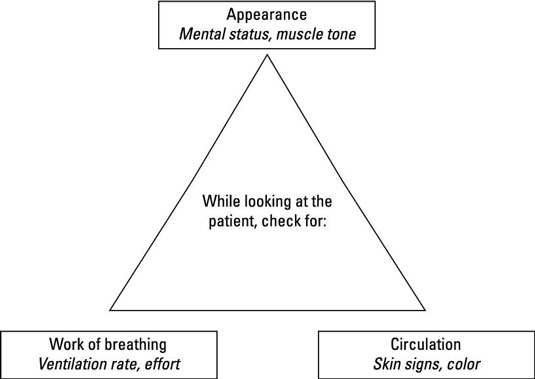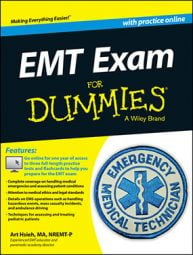You will need to know how to treat a pediatric patient as an EMT. For children ranging from infant to toddlers, performing the pediatric assessment triangle (PAT) can help you to quickly determine how critical the situation is without rushing right up to the child. As you enter the scene, take a moment to look at the following signs:
Appearance: Is the child awake? Crying? Clinging to the caregiver? Those are signs of adequate oxygenation and circulation to the child’s brain. You should be concerned about a child who is quiet, crying weakly, not recognizing the caregiver, or sleepy and hard to arouse.
Work of breathing: Keep in mind that fast breathing is fine, so long as the child doesn’t appear tired, anxious, or frightened. Be concerned if the child is working hard to breathe, showing signs of accessory muscle use, or seesaw breathing.
Circulation to skin: The skin should have good color. Any mottling, pallor (significant paleness), or cyanosis is a bad sign that requires your immediate attention.

After performing the PAT, you can begin your “close-up” assessment of the child. Here are a few other guidelines for assessing kids of all ages:
If the toddler or preschool child is not critically ill or injured, performing a toe-to-head physical exam may be less intrusive and frightening to the patient.
Keep the caregiver close by when evaluating younger patients. Parents can often tell you subtle things they notice about their children. Explain what you are doing when performing an exam or procedure.
If the child is older, don’t ignore what he wants to say or do, and don’t keep him out of any discussions with caregivers. Even preschoolers will understand at least some of what you’re saying. Absolutely do not hide anything or lie about what you’re doing. You’ll have a hard time reestablishing any trust with the child once it’s broken.
If the child has a special toy or other object that provides reassurance or comfort, allow him to bring it along. An older child is inquisitive, even if he doesn’t feel well. Penlights, a stethoscope, or the back of an ambulance can capture a child’s attention and allow you to perform additional exams and procedures.
A parent is holding his 18-month-old infant in his arms. You can see that the infant appears limp, is breathing rapidly, and has pale skin. You should
(A)have the parent hand the infant to you.
(B)perform a toe-to-head assessment.
(C)assess the infant’s airway and breathing while in the parent’s arms.
(D)ask the parent about the infant’s medical history.
The best answer is Choice (A). Your PAT assessment reveals an infant who is very sick. You need to rapidly conduct a primary assessment and provide care as soon as possible. Maintaining the infant in the parent’s arms, Choice (C), will inhibit you from assessing the infant fully. Choice (B) is part of the secondary assessment, as is Choice (D).

